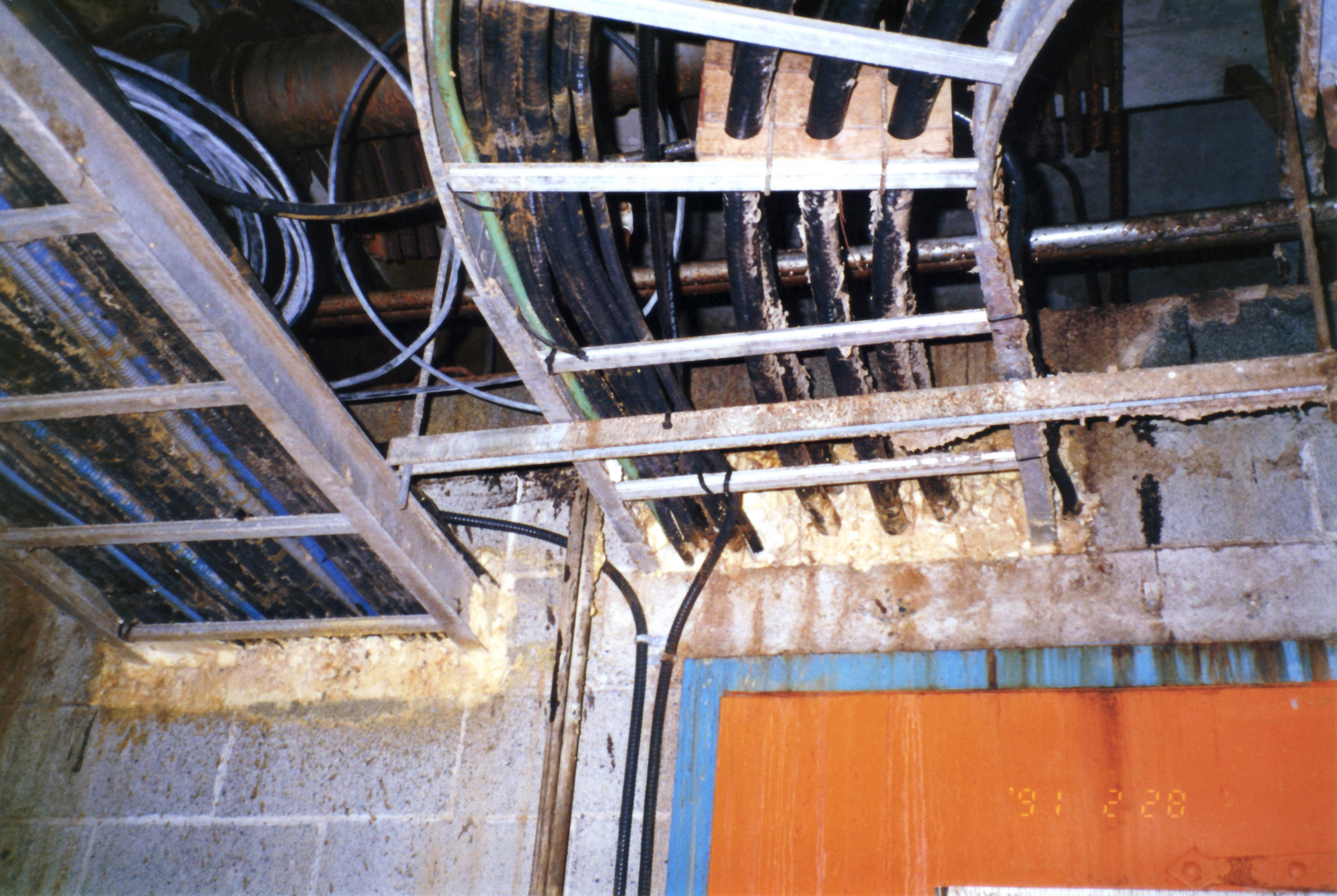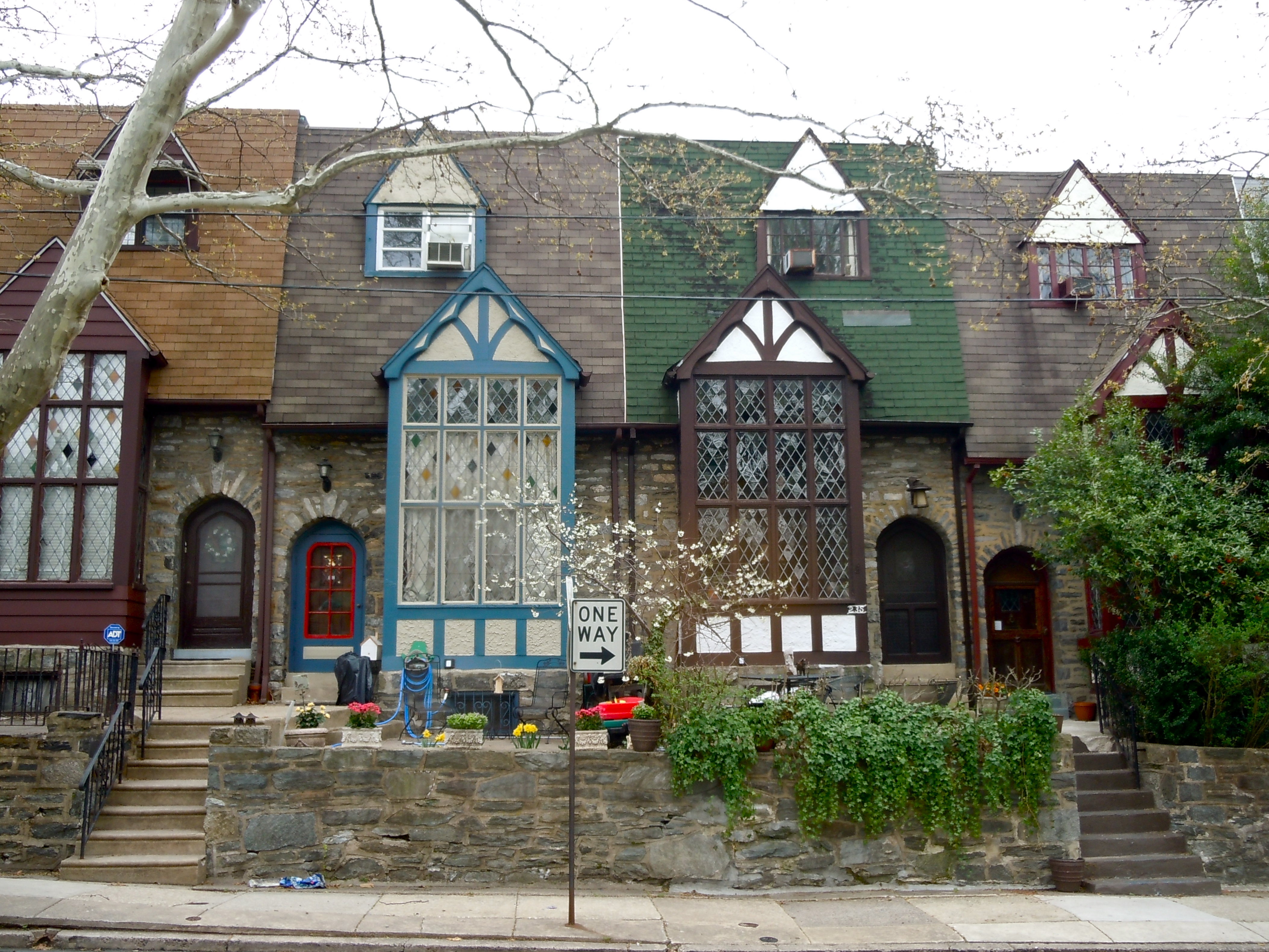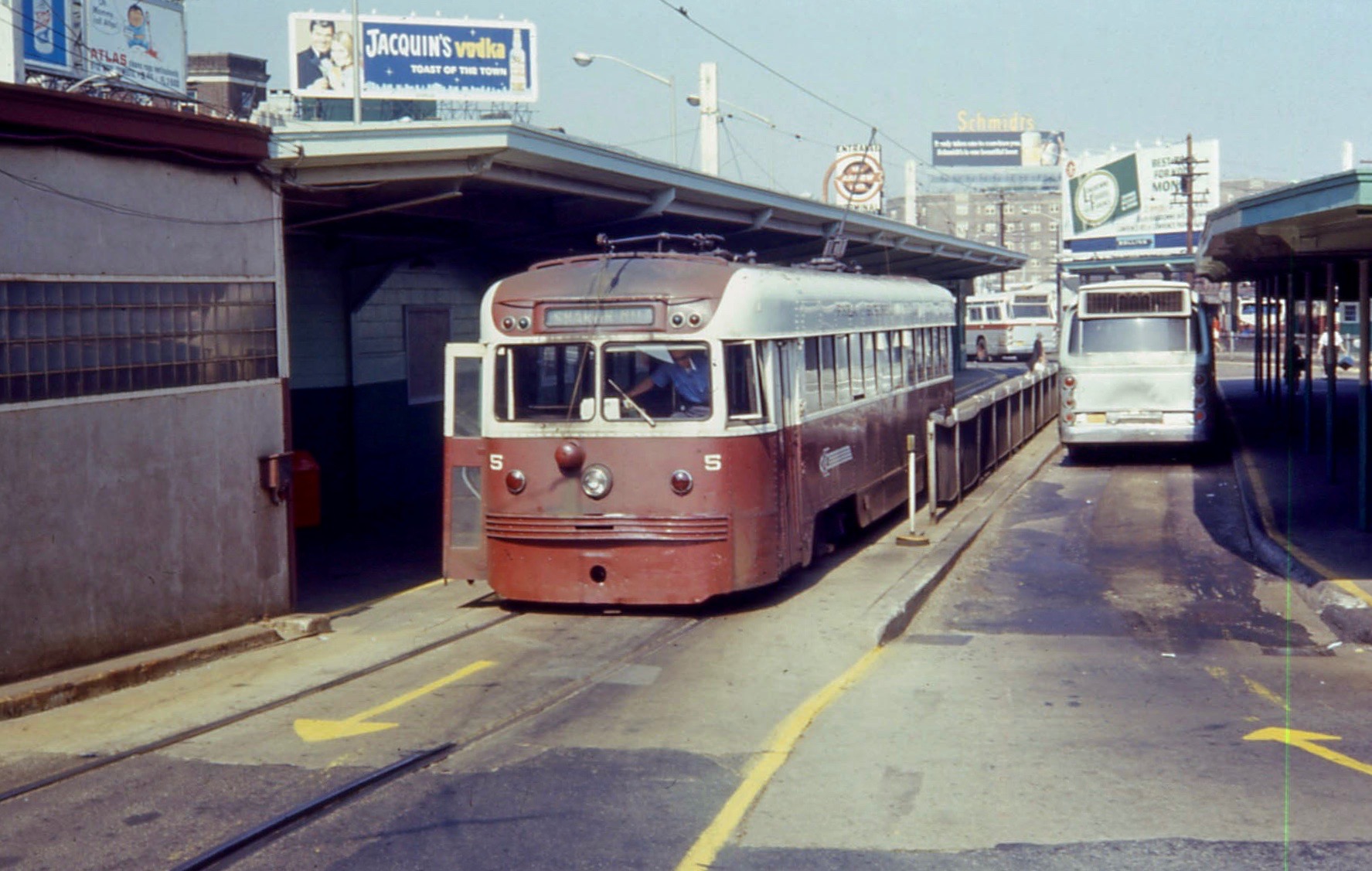|
15th Street (SEPTA Station)
15th Street station is a subway station in Philadelphia. It is served by SEPTA's Market–Frankford Line and all routes of the subway–surface trolley lines. A free interchange also provides access to the Broad Street Line at City Hall station, which is connected to 15th Street by the Downtown Link underground concourse. The concourse also connects to Regional Rail lines at Suburban Station. It is the busiest station on the Market–Frankford Line, with 29,905 boardings on an average weekday. The station is in the very heart of Center City Philadelphia. City Hall lies across the street from the station, and attractions as Love Park, the Penn Center area, and the Comcast Center are within walking distance. History 15th Street was the original eastern terminus of the Market–Frankford subway–elevated, which was opened by the Philadelphia Rapid Transit Company on August 3, 1907, and ran west to 69th Street in Upper Darby. The line was eventually extended eastward to ... [...More Info...] [...Related Items...] OR: [Wikipedia] [Google] [Baidu] |
Market Street (Philadelphia)
Market Street, originally known as High Street, is a major east–west street in Philadelphia. The street is signed as Pennsylvania Route 3 between 38th Street ( U.S. Route 13) and 15th Street ( PA 611). A short portion of the road continues west from Cobbs Creek Parkway (63rd Street) to Delaware County, adjacent to Philadelphia. ‘High Street’ was the familiar name of the principal street in nearly every English town at the time Philadelphia was founded. But if Philadelphia was indebted to England for the name of High Street, nearly every American town is, in turn, indebted to Philadelphia for its Market Street. Long before the city was laid out or settled, Philadelphia's founder, William Penn, had planned that markets would be held regularly on the wide High Street. The city's first market stalls were situated in the center of the thoroughfare starting at Front Street and proceeding west eventually to 8th Street. The stalls soon became covered and were not taken down as pl ... [...More Info...] [...Related Items...] OR: [Wikipedia] [Google] [Baidu] |
Philadelphia City Hall
Philadelphia City Hall is the seat of the municipal government of the City of Philadelphia. Built in the ornate Second Empire style, City Hall houses the chambers of the Philadelphia City Council and the offices of the Mayor of Philadelphia. It is also a courthouse, serving as the seat of the First Judicial District of Pennsylvania, and houses the Civil Trial and Orphans' Court Divisions of the Court of Common Pleas of Philadelphia County. Built of brick, white marble, and limestone, Philadelphia City Hall is the world's largest free-standing masonry building and was the world's tallest habitable building upon its completion in 1894. In 1976, it was designated a National Historic Landmark, and in 2006, was also named a National Historic Civil Engineering Landmark by the American Society of Civil Engineers. History and description The building was designed by Scottish-born architect John McArthur Jr. and Thomas Ustick Walter [...More Info...] [...Related Items...] OR: [Wikipedia] [Google] [Baidu] |
15th Street SEPTA 2017 Outside
15 (fifteen) is the natural number following 14 and preceding 16. Mathematics 15 is: * A composite number, and the sixth semiprime; its proper divisors being , and . * A deficient number, a smooth number, a lucky number, a pernicious number, a bell number (i.e., the number of partitions for a set of size 4), a pentatope number, and a repdigit in binary (1111) and quaternary (33). In hexadecimal, and higher bases, it is represented as F. * A triangular number, a hexagonal number, and a centered tetrahedral number. * The number of partitions of 7. * The smallest number that can be factorized using Shor's quantum algorithm. * The magic constant of the unique order-3 normal magic square. * The number of supersingular primes. Furthermore, * 15 is one of two numbers within the ''teen'' numerical range (13-19) not to use a single-digit number in the prefix of its name (the first syllable preceding the ''teen'' suffix); instead, it uses the adjective form of five ... [...More Info...] [...Related Items...] OR: [Wikipedia] [Google] [Baidu] |
Mebibyte
The byte is a unit of digital information that most commonly consists of eight bits. Historically, the byte was the number of bits used to encode a single character of text in a computer and for this reason it is the smallest addressable unit of memory in many computer architectures. To disambiguate arbitrarily sized bytes from the common 8-bit definition, network protocol documents such as The Internet Protocol () refer to an 8-bit byte as an octet. Those bits in an octet are usually counted with numbering from 0 to 7 or 7 to 0 depending on the bit endianness. The first bit is number 0, making the eighth bit number 7. The size of the byte has historically been hardware-dependent and no definitive standards existed that mandated the size. Sizes from 1 to 48 bits have been used. The six-bit character code was an often-used implementation in early encoding systems, and computers using six-bit and nine-bit bytes were common in the 1960s. These systems often had memory words ... [...More Info...] [...Related Items...] OR: [Wikipedia] [Google] [Baidu] |
WHYY-FM
WHYY-FM (90.9 MHz, "91 FM") is a public radio station licensed to serve Philadelphia, Pennsylvania. Its broadcast tower is located in the city's Roxborough neighborhood at () while its studios and offices are located on Independence Mall in Center City, Philadelphia. The station, owned by WHYY, Inc., is a charter member of National Public Radio (NPR) and contributes several programs to the national network. History WHYY signed on the air on December 14, 1954, owned by the Metropolitan Philadelphia Educational Radio and Television Corporation. It was the first educational station in Philadelphia. The transmitter, originally located at 17th and Sansom Streets in Philadelphia, was donated by Westinghouse Broadcasting. In 1957, it added a sister television station, WHYY-TV on channel 35. In 1963, WHYY-TV moved from channel 35 in Philadelphia to the stronger channel 12 in Wilmington, Delaware. At the time, Federal Communications Commission (FCC) regulations did not allow co-own ... [...More Info...] [...Related Items...] OR: [Wikipedia] [Google] [Baidu] |
Building Code
A building code (also building control or building regulations) is a set of rules that specify the standards for constructed objects such as buildings and non-building structures. Buildings must conform to the code to obtain planning permission, usually from a local council. The main purpose of building codes is to protect public health, safety and general welfare as they relate to the construction and occupancy of buildings and structures. The building code becomes law of a particular jurisdiction when formally enacted by the appropriate governmental or private authority. Building codes are generally intended to be applied by architects, engineers, interior designers, constructors and regulators but are also used for various purposes by safety inspectors, environmental scientists, real estate developers, subcontractors, manufacturers of building products and materials, insurance companies, facility managers, tenants, and others. Codes regulate the design and cons ... [...More Info...] [...Related Items...] OR: [Wikipedia] [Google] [Baidu] |
Americans With Disabilities Act Of 1990
The Americans with Disabilities Act of 1990 or ADA () is a civil rights law that prohibits discrimination based on disability. It affords similar protections against discrimination to Americans with disabilities as the Civil Rights Act of 1964, which made discrimination based on race, religion, sex, national origin, and other characteristics illegal, and later sexual orientation and gender identity. In addition, unlike the Civil Rights Act, the ADA also requires covered employers to provide reasonable accommodations to employees with disabilities, and imposes accessibility requirements on public accommodations. In 1986, the National Council on Disability had recommended the enactment of an Americans with Disabilities Act (ADA) and drafted the first version of the bill which was introduced in the House and Senate in 1988. A broad bipartisan coalition of legislators supported the ADA, while the bill was opposed by business interests (who argued the bill imposed costs on b ... [...More Info...] [...Related Items...] OR: [Wikipedia] [Google] [Baidu] |
Disabled In Action Of Pennsylvania
Disability is the experience of any condition that makes it more difficult for a person to do certain activities or have equitable access within a given society. Disabilities may be cognitive, developmental, intellectual, mental, physical, sensory, or a combination of multiple factors. Disabilities can be present from birth or can be acquired during a person's lifetime. Historically, disabilities have only been recognized based on a narrow set of criteria—however, disabilities are not binary and can be present in unique characteristics depending on the individual. A disability may be readily visible, or invisible in nature. The United Nations Convention on the Rights of Persons with Disabilities defines disability as: Disabilities have been perceived differently throughout history, through a variety of different theoretical lenses. There are two main models that attempt to explain disability in our society: the medical model and the social model. The medical model serves as ... [...More Info...] [...Related Items...] OR: [Wikipedia] [Google] [Baidu] |
2nd Street Station (SEPTA)
2nd Street station (signed as 2nd Street–Penn's Landing–Old City on platforms) is a subway station on the Market-Frankford Line, beneath the intersection of 2nd Street and Market Street in Center City Philadelphia, Pennsylvania. It is the easternmost stop in Center City and also the easternmost underground stop on the line. The station serves the Old City neighborhood of Philadelphia, with station signs originally reading "Olde City". The 'e' has been covered on the signs with obvious blue stickers. The station also serves Penn's Landing and Spruce Street Harbor Park along the Delaware River. 2nd Street is also served by SEPTA bus routes 5, 17, 33, and 48 also serve the station. History The station opened August 3, 1908 as part of the first extension of the Philadelphia Rapid Transit Company's Market Street Subway. The line had originally opened a year earlier between 69th Street and City Hall. The station was the eastern terminal of the line until September 7 of ... [...More Info...] [...Related Items...] OR: [Wikipedia] [Google] [Baidu] |
Upper Darby, Pennsylvania
Upper Darby Township, often shortened to Upper Darby, is a home rule township in Delaware County, Pennsylvania. The township borders Philadelphia, the nation's sixth most populous city as of 2020 with 1.6 million residents. As of the 2020 census, the township had a total population of 85,681, making it the sixth most populated city or borough in Pennsylvania, after Philadelphia, Pittsburgh, Allentown, Reading, and Erie. Upper Darby is 65% residential, 25% commercial, and 8% other. Upper Darby is home to the Tower Theater, a historic music venue on 69th Street built in the 1920s, and is also home to several Underground Railroad sites. Upper Darby's population is diverse, representing over 100 ethnic cultures. The township hosts a range of housing types including densely populated rowhouse sections similar to houses in neighboring West Philadelphia, tree-lined neighborhoods of turn-of-the-century single-family houses and mid-century developments. Because of a home-rule char ... [...More Info...] [...Related Items...] OR: [Wikipedia] [Google] [Baidu] |
69th Street Transportation Center
The 69th Street Transportation Center is a SEPTA terminal in the Terminal Square section of Upper Darby, Pennsylvania, just west of the city limits of Philadelphia. The terminal serves the Market–Frankford Line, Norristown High Speed Line, and the Media–Sharon Hill Line trolleys, and multiple bus routes. It is located at the end of 69th Street, a major retail corridor in Upper Darby, across Market Street ( Route 3) from the Tower Theater. Until 2011, the station was primarily known as 69th Street Terminal. 69th Street is the second busiest transfer point in the SEPTA system (after 15th Street/ City Hall station) serving 35,000 passengers every weekday. It is also the only SEPTA facility to serve both City Transit and Suburban Transit routes. History 69th Street is one of the original Market Street Elevated stations built by the Philadelphia Rapid Transit Company; the line opened for service on March 4, 1907 between here and stations. Shortly after on May 22 of the same ye ... [...More Info...] [...Related Items...] OR: [Wikipedia] [Google] [Baidu] |
Philadelphia Rapid Transit Company
The Philadelphia Transportation Company (PTC) was the main public transit operator in Philadelphia, Pennsylvania, from 1940 to 1968. A private company, PTC was the successor to the Philadelphia Rapid Transit Company (PRT), in operation since 1902, and was the immediate predecessor of the Southeastern Pennsylvania Transportation Authority (SEPTA). History PTC was established on January 1, 1940, by the merger of the PRT and several smaller, then-independent transit companies operating in and near the city. It operated a citywide system of bus, trolley, and trackless trolley routes, the Market–Frankford Line (subway-elevated rail), the Broad Street Line (subway), and the Delaware River Bridge Line (subway-elevated rail to City Hall, Camden, New Jersey, and now part of the PATCO Speedline) which became SEPTA's City Transit Division. PTC operated the rapid transit lines in urban Philadelphia – principally the Market–Frankford Line and Broad Street Line – leasing their fixe ... [...More Info...] [...Related Items...] OR: [Wikipedia] [Google] [Baidu] |
.jpg)
_p11_STATUE_OF_WILLIAM_PENN.jpg)







_Bridge_Line_&_Fare_Tokens.jpg)